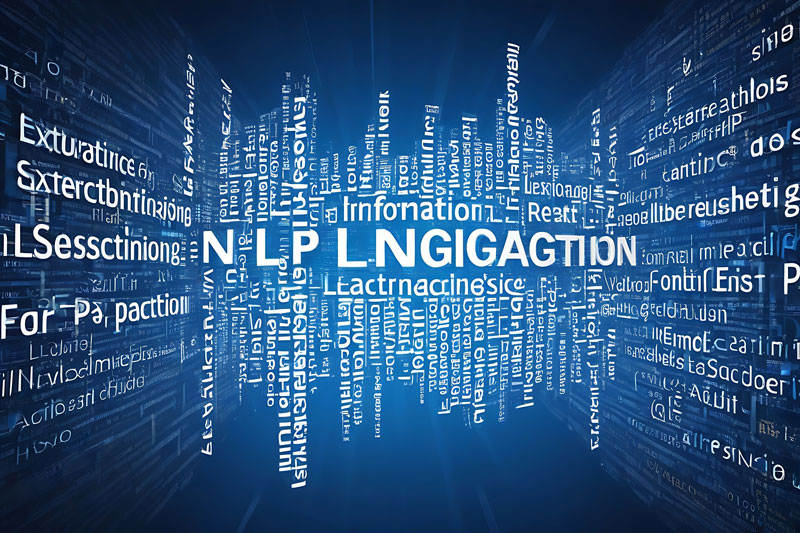Natural Language Processing (NLP) Information Extraction is a field at the intersection of linguistics and artificial intelligence that focuses on automatically retrieving structured information from unstructured textual data. It involves extracting meaningful insights, entities, relationships, and patterns from vast volumes of text, enabling machines to understand and interpret human language more effectively.
Named Entity Recognition in Spacy | Huggingface With Explanation
Speech Emotion Recognition Example with Code & Database
Get Contextual Embeddings from BERT
you may be interested in the articles above in irabrod.
what is Information extraction
Natural Language Processing (NLP) Information Extraction is a pivotal area within the domain of artificial intelligence that strives to uncover valuable and structured knowledge from unstructured text sources. By harnessing advanced computational techniques, NLP Information Extraction empowers machines to decipher, interpret, and distill relevant entities, facts, and connections embedded within the complexities of human language.
Key Elements:
1. Textual Understanding: NLP Information Extraction involves the comprehension and interpretation of unstructured text, encompassing various forms such as articles, documents, emails, and social media posts.
2. Entity Recognition: It encompasses identifying and categorizing specific elements within the text, such as names of people, organizations, locations, dates, and more, known as named entity recognition.
3. Relationship Extraction: This facet involves discerning connections and associations between entities, allowing for the extraction of meaningful relationships or dependencies.
4. Event Extraction: The process of identifying events or occurrences mentioned in the text, along with relevant details like dates, times, locations, and involved entities.
5. Information Structuring: Converting extracted data into a structured format (such as databases or knowledge graphs) for easier analysis and utilization by machines.
Applications:
NLP Information Extraction finds applications across various domains:
– Information Retrieval: Facilitating search engines to fetch relevant information.
– Chatbots and Virtual Assistants: Enabling conversational agents to understand user queries and provide accurate responses.
– Sentiment Analysis: Analyzing opinions, emotions, or attitudes expressed in text data.
– Financial Analysis: Extracting insights from financial reports, market news, and business documents.
– Healthcare: Identifying relevant information from medical records, research papers, and clinical notes.
Challenges:
The complexity of natural language, including ambiguities, nuances, and variations in expression, presents several challenges in NLP Information Extraction. Ambiguities in language, variations in context, and the need to handle large-scale data effectively are some of the primary hurdles.
what is Information extraction
Information extraction (IE) is a subfield of natural language processing (NLP) that involves automatically extracting structured information from unstructured textual data. Its primary goal is to identify and collect specific pieces of information, such as entities, relationships, events, and attributes, from large volumes of text.
Key Components of Information Extraction:
1. Named Entity Recognition (NER): Identifying and classifying entities mentioned in text, such as names of persons, organizations, locations, dates, numerical expressions, and more.
2. Relation Extraction: Determining relationships or connections between entities mentioned in the text. For instance, extracting relationships between a person and an organization, or between different entities in a sentence.
3. Event Extraction: Recognizing events or happenings described in the text, along with relevant details such as time, location, participants, and outcomes.
4. Template or Pattern-based Extraction: Using predefined templates or patterns to extract specific information based on known structures or formats. This method is often employed when dealing with structured text.
5. Semantic Role Labeling (SRL): Identifying the roles that different phrases or words play in the context of a sentence, such as the subject, object, or predicate.
Applications of Information Extraction:
1. Search Engines: Enhancing search results by providing more structured and relevant information from unstructured text sources.
2. Question Answering Systems: Enabling systems to extract specific answers from textual sources to respond to user queries.
3. Summarization: Assisting in summarizing large volumes of text by extracting crucial information.
4. Business Intelligence: Extracting information from documents, emails, or reports for business analytics and decision-making.
5. Knowledge Graph Construction: Building structured knowledge graphs by extracting entities and relationships from text, aiding in data representation and analysis.
Challenges in Information Extraction:
– Ambiguity and Context: Natural language often contains ambiguities, making it challenging to extract accurate information without considering the context.
– Language Variability: Variations in language, grammar, syntax, and expressions across different texts and domains pose challenges in designing universal extraction models.
– Scalability: Processing large volumes of text in real-time while maintaining efficiency and accuracy.
Overall, information extraction plays a crucial role in converting unstructured textual data into structured formats, enabling computers to understand, interpret, and utilize the information contained within natural language text more effectively.
python tools for information extraction
Python offers a rich ecosystem of modules and tools for information extraction from text, websites, and other unstructured data sources. Here are some prominent ones:
1. Natural Language Processing (NLP) Libraries:
– NLTK (Natural Language Toolkit): A comprehensive library offering tools for tokenization, POS tagging, parsing, and named entity recognition (NER).
– Spacy: An efficient library for NLP tasks like entity recognition, dependency parsing, and POS tagging with pre-trained models.
– TextBlob: A simple NLP library providing easy-to-use interfaces for tasks like part-of-speech tagging, noun phrase extraction, and sentiment analysis.
2. Web Scraping and Parsing:
– Beautiful Soup: A powerful library for extracting data from HTML and XML files, commonly used for web scraping.
– Scrapy: A more advanced framework for web scraping and crawling websites, offering tools for data extraction from multiple pages and sites.
3. Named Entity Recognition (NER):
– Spacy NER: Integrated within the Spacy library, providing high-quality entity recognition capabilities.
– Stanford NER: Java-based, but can be accessed in Python using NLTK or standalone libraries, capable of recognizing named entities in text.
4. Machine Learning and Text Analysis:
– Scikit-learn: Offers a suite of tools for text feature extraction, classification, clustering, and more.
– Gensim: Primarily used for topic modeling, but also supports information retrieval and similarity analysis.
– TensorFlow and PyTorch: Deep learning frameworks useful for building custom models for information extraction tasks, especially when dealing with complex patterns or structures.
5. Pre-trained Language Models:
– Hugging Face Transformers: A repository offering pre-trained transformer-based models (e.g., BERT, GPT) for various NLP tasks, including information extraction.
– Stanford CoreNLP: A suite of NLP tools that include models for NER, parsing, sentiment analysis, and more.
6. Data Annotation Tools:
– Prodigy: An annotation tool that helps label data for NLP tasks, useful for creating datasets for training models for information extraction.
These tools and libraries provide a wide range of functionalities and approaches for extracting information from text, websites, and other sources. Choosing the right tool often depends on the specific requirements, data formats, and the complexity of the information extraction task at hand.
Python information extraction
BERT
Using BERT for information extraction typically involves fine-tuning a pre-trained BERT model on a specific task or creating a pipeline to extract information from text. Here’s a simple example demonstrating how to use BERT through the Hugging Face Transformers library for named entity recognition (NER), a common information extraction task:
Firstly, ensure you have the `transformers` library installed:
pip install transformers
Here’s an example of using BERT for named entity recognition:
from transformers import pipeline
# Load the NER pipeline using BERT
ner_pipeline = pipeline("ner", model="bert-base-uncased", tokenizer="bert-base-uncased")
# Example text for information extraction
text = "Apple is looking to buy a startup in the UK for $1 billion."
# Perform named entity recognition
extracted_info = ner_pipeline(text)
# Display extracted entities and their labels
for entity in extracted_info:
print(f"Entity: {entity['word']}, Label: {entity['entity']}")
Explanation:
1. Importing the `pipeline` function: The Hugging Face library `transformers` provides a high-level `pipeline` interface that simplifies the use of pre-trained models like BERT for various NLP tasks.
2. Initializing the NER pipeline: Using `pipeline(“ner”, model=”bert-base-uncased”, tokenizer=”bert-base-uncased”)`, you create a Named Entity Recognition pipeline that uses the BERT model (`bert-base-uncased`) and its tokenizer (`bert-base-uncased`).
3. Defining the text: This is the sample text from which we want to extract named entities.
4. Performing NER: The `ner_pipeline` is applied to the text, and the output consists of a list of dictionaries, each containing the identified entities (`’word’`) and their corresponding labels (`’entity’`).
5. Displaying extracted entities: The extracted entities and their labels are printed in this example.
This program demonstrates a simple use case of BERT for named entity recognition. BERT, being a transformer-based model, is well-suited for various information extraction tasks when fine-tuned on specific datasets or when used in conjunction with other techniques for entity extraction, summarization, or question-answering tasks. Fine-tuning BERT on domain-specific data can further enhance its performance for specialized information extraction tasks.
Spacy
Here’s an example of performing named entity recognition (NER) using SpaCy, which is known for its efficiency in various NLP tasks:
import spacy
# Load the SpaCy English model with NER component
nlp = spacy.load("en_core_web_sm")
# Example text for information extraction
text = "Apple is looking to buy a startup in the UK for $1 billion."
# Process the text with SpaCy
doc = nlp(text)
# Extract named entities and their labels
for ent in doc.ents:
print(f"Entity: {ent.text}, Label: {ent.label_}")
Explanation:
1. Importing SpaCy and loading the English model: The code imports SpaCy and loads the English language model (`en_core_web_sm` in this case), which includes components for various NLP tasks like named entity recognition (NER).
2. Defining the text: This is the sample text from which we want to extract named entities.
3. Processing the text with SpaCy: The `nlp` object created with SpaCy’s loaded model is used to process the input text (`doc = nlp(text)`). This step tokenizes the text, performs part-of-speech tagging, dependency parsing, and named entity recognition.
4. Extracting named entities: The processed `doc` object contains entities identified by SpaCy during NER. The `ents` attribute provides access to these entities, and each entity (`ent`) contains the text (`ent.text`) and its corresponding label (`ent.label_`).
5. Displaying extracted entities: The extracted entities and their labels are printed in this example.
SpaCy provides a straightforward way to perform NER and other NLP tasks. Its pre-trained models, like the `en_core_web_sm` used here, have components for NER that can identify entities such as persons, organizations, locations, and more in text data. Customization and training on domain-specific data can further improve the accuracy of named entity recognition with SpaCy.
Conclusion
In summary, the tools demonstrated—BERT through the Hugging Face Transformers library and SpaCy—offer powerful capabilities for information extraction in Natural Language Processing (NLP). Here’s a concise conclusion:
1. BERT and Hugging Face Transformers:
– BERT, as a transformer-based model, excels in various NLP tasks and can be fine-tuned for specific tasks like named entity recognition (NER).
– The Hugging Face Transformers library simplifies the use of BERT and other transformer models, providing easy-to-use pipelines for NLP tasks.
2. SpaCy:
– SpaCy is known for its efficiency and ease of use in NLP tasks, including named entity recognition.
– It comes with pre-trained models, like `en_core_web_sm`, that offer components for entity recognition and other NLP tasks out of the box.
3. Functionality and Use Cases:
– BERT, when fine-tuned on specific datasets, can provide highly accurate information extraction, especially in complex contexts or specialized domains.
– SpaCy, with its pre-trained models and straightforward API, is suitable for rapid prototyping, basic NER tasks, and initial exploration of text data.
4. Performance and Customization:
– BERT, due to its transformer architecture, may require more computational resources and time for fine-tuning on domain-specific data but can achieve state-of-the-art performance.
– SpaCy, with its ease of use and pre-trained models, offers good performance out of the box but can also be further customized and trained on specific datasets for improved accuracy in NER tasks.
5. Choosing the Right Tool:
– Selecting between BERT and SpaCy often depends on the specific requirements of the task, the available resources, and the desired level of accuracy or customization.
– BERT, with its transformer architecture, is suitable for advanced NLP tasks and when high accuracy is critical, while SpaCy is efficient for rapid prototyping and handling basic NER tasks.
In conclusion, both BERT and SpaCy serve as valuable tools for information extraction in NLP, each offering its own strengths and use cases. Choosing the appropriate tool depends on the task’s complexity, available resources, and the level of accuracy required for the information extraction task at hand.








